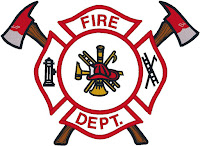 |
| Firefighter trumpet |
In the past, when human lung power was the driver, it was well known that an unaided shouting human voice could reach perhaps 100 yards. Perhaps greater range was obtained by cupping one's hands around the mouth to "focus" the sound. From cupped hands it was a short step to creating "speaking cones" or megaphones to enhance the human voice. Firefighter leaders
 used "speaking trumpets" to make themselves heard. Even today a common feature of a firefighter logo carries the image of one of these trumpets on it.
used "speaking trumpets" to make themselves heard. Even today a common feature of a firefighter logo carries the image of one of these trumpets on it.At loud noisy venues, like a college football game, large megaphones were used by cheerleaders to get the crowd involved. Some coaches used them at
practice.
As the world has gotten more high tech, we've moved from shouting to using electronics to amplify our voices. Most emergency plans now call for the use of a "public address system" as an aid in moving from the chaos of an emergency to some sort of order. Emergency planning should include having equipment in place to communicate with workers, customers and neighbors that something is amiss or a threat is looming. See here.
Having equipment that is not dependent on normal electric sources is vital. For offices in a tall building, floor wardens might be issued battery powered bullhorns. There are many of these available. Some are more elaborate than others, as seen in the following demonstrations (I am not endorsing the products in the videos - just thought they made some good points):
With modern tech, there are developments of "wifi" driven public address systems, as set out here:
The WiFi Bullhorn is designed to assist emergency workers in the event of a disaster situation by offering a rapidly configurable wireless public address system for disaster sites. The current configuration plays either pre recorded or custom recorded messages and utilizes 802.11b networks for communication. Units can be position anywhere wireless coverage exists to help manage crowds or to recall first responders from dangerous areas.See also here:
Whenever a crisis requires a large evacuation, effective communication is vital to the success of any response operation. All too often, emergency situations create obstacles to communication – power may be cut off, access routes may be blocked, isolated response teams may be operating with inaccurate information, or teams may have difficulty getting instructions to large groups of frightened civilians. The potential negative consequences for local governments, schools, businesses, sports arenas, and other public areas are obvious and overwhelming. ***All this is true for your home or workplace, too. Having even a low-cost battery powered bullhorn or its kin may save lives and help organize recovery.
In establishing disaster preparedness plans, emergency personnel in all settings should have equipment on hand to guarantee that, whatever obstacles arise, communication lines will remain available. Such equipment needs to meet a number of criteria, including:
• Portability—the communication unit must go wherever the response teams go, with a minimum of weight and space.
• Power –the unit must operate with battery back-up for long time periods without the need for outside power.
• Versatility—one-to-one communication between team leaders must be available, as well as the capacity to address larger groups of responders and civilians.
• Cost Effectiveness—the unit must be affordable enough to be available to all sizes and types of response organizations, including in-house safety teams and local public safety officials.
For example, imagine a severe wind storm that has dropped trees onto streets in you neighborhood, rendering it impassable for emergency vehicles. With a bullhorn, you could direct people to walk to a safe spot - like nearby school or park, to which they can bring water, food, medical kits and slightly injured people for treatment. You could ask people in houses who need help or who are unable to walk to put out a sign of some sort so help can be directed to them.
The important thing is that communications is key - to quelling panic and to organizing a response. Portable public address systems can be an valuable addition to the disaster prep tool box.


Te Federal Signal Voicegun is a superb bullhorn, albiet a bit pricy.
ReplyDelete